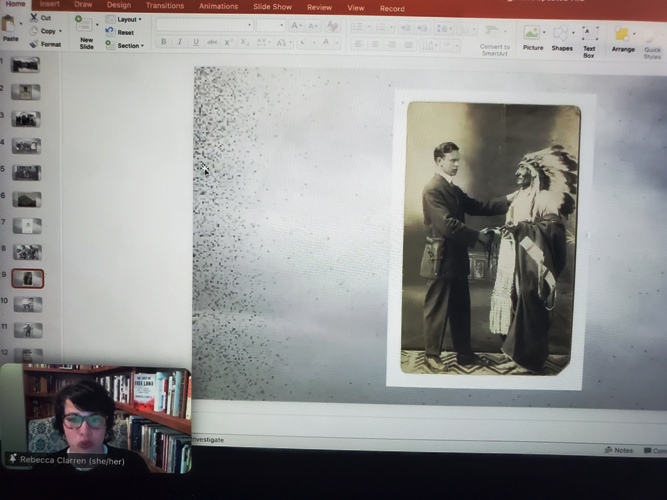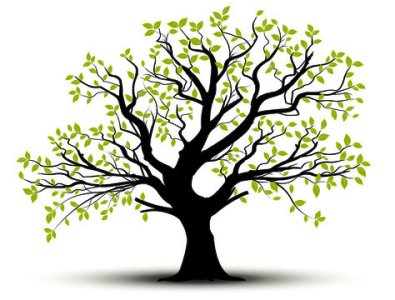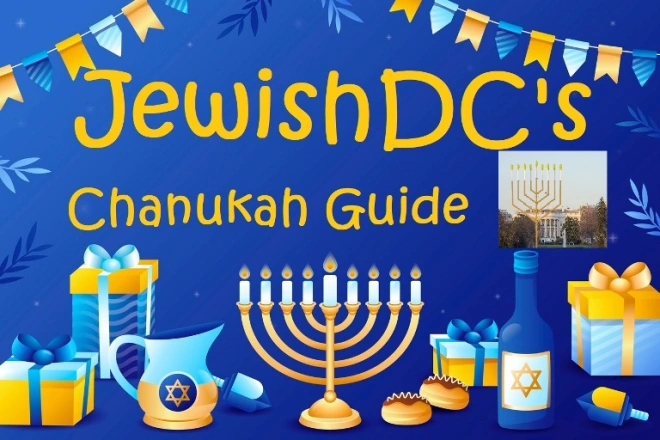
Clarren’s slideshow includes a picture of her great-uncle, Jack Sinykin, shaking hands with a Lakota man. Some tribal elders believe him to be the warrior, Joseph White Bull, nephew of Sitting Bull. / photo taken by Rachel Mauro
Religion sometimes gets a bad rap for being disconnected from modern life, but Rebecca Claren found a reason to turn to ancient wisdom.
In her book, The Cost of Free Land: Jews, Lakota, and an American Inheritance, which she spoke about with the Adas Israel and Congregation Beth El book club on April 7, she delved into how to make amends for the theft of indigenous territory.
Technically, Clarren’s family wasn’t directly responsible for the theft. They immigrated to immigrated to the United States from czarist Russia in the early 20th century, after one of her ancestors was brutalized in a pogrom. Many Americans and soon-to-be Americans of this time period decided to move out west. Some were incentivized by the Homestead Act. Passed by the Lincoln administration in 1862, it allowed for individuals who had not taken up arms against the U.S. to claim 160 acres of surveyed government land. If they lived and improved (eg, cultivated and built a home) on the land, after six years it would become theirs.
Clarren’s ancestors took up this offer, and moved to South Dakota, to prairie land that became known as “Jew Flats.” She credited this history of catapulting her family into the middle class. It wasn’t until she herself became a journalist that she started to realize that their land had once belonged to the Lakota people.
Through slides Clarren brought slides to share during the zoom call, she wove a narrative with family photos and historical documents. She pushed into the truth behind the history: the American government broke their land promise to the Lakota people because they wanted to build a railroad to lucrative California. They started killing buffalo, upon which Lakota civilization was built (one photo featured a mound of buffalo skulls over two stories high.) They criminalized Lakota religion and often took children away to assimilate them.
The family photos like the one above prompted Clarren to ask questions, especially since her community was largely uninvolved with their Lakota neighbors. Through talking with Lakota elders, Clarren came to the realization that true repentance for benefiting off of another’s pain would come from her own indigenous cultural sources. Thus, Clarren began studying Jewish texts with her rabbi, Benjamin Barnett.
The example she shared with us comes from the Talmud, where the schools of Hillel and Shammai were arguing over what to do if one took ownership of a building, and it was then discovered part of its foundation (a beam) was stolen. Should the entire building be dismantled (Shammai)? Or can the building stay up, but the cost of the beam be paid back (Hillel)? As is general modern custom among Jews, Clarren followed the path of Hillel.
In this circumstance, it’s a little more complicated than paying a price for something tangible. Her family sold off their ranch in “Jew Flats” back in 1970, to non-indigenous owners. Currently, beyond promoting her book, Clarren and her family created a fund to assist the Native-led non-profit, Indian Land Tenure Foundation.
She also has resources for others in the U.S. to learn about indigenous peoples, their history and what they face today. In the zoom chat of about 180 people, folks in the DC area referenced the Anacostan, Piscataway and Pamunkey peoples as a starting point.
Clarren’s talk hit close to home for me–literally. My Jewish family also escaped the Pale of Settlement around the same time as hers (my great-grandfather’s parents came from Minsk, very close to where her ancestors lived.) Both of our families also settled in the midwest, though mine didn’t take part in homesteading. Still, this opened a door for me to research this history more thoroughly, and find ways to make amends for the wrongs of the past.
Also in DC on the 7th, a rally for the Israeli hostages was held on the National Mall, to protest their six months in captivity. Former hostages, family of hostages and politicians addressed the 1,000-strong crowd. And with Passover coming up, the Hostages and Missing Families Forum created a special Haggadah. Produced by a printing press in one of the targeted kibbutzim, the Haggadah features “messages of hope and inspiration by Israeli spiritual and cultural leaders.”
For more of my literary coverage, check out the Books, Plays, Movies and Music tab. Chag sameach, and may we all embark on the journey towards freedom.











